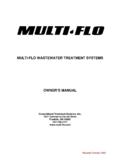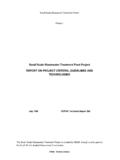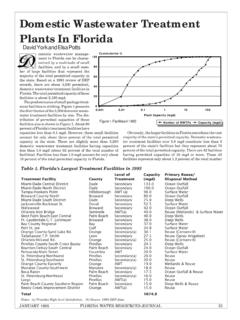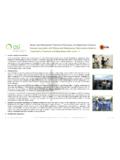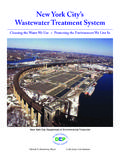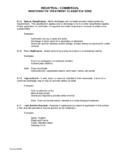Transcription of WASTEWATER TREATMENT SYSTEMS
1 WASTEWATER TREATMENT SYSTEMS . MANUAL. FOR. OPERATION, MAINTENANCE. AND. TROUBLE-SHOOTING GUIDE. A Division of Consolidated TREATMENT SYSTEMS , Inc. 1501 Commerce Center Drive Franklin, OH 45005. Tel: 937-746-2727. Fax: 937-746-1446. I. BASIC OPERATION AND MAINTENANCE REQUIREMENTS. The following is a description of the normal maintenance required to insure continuous satisfactory operation of the MULTI-FLO SYSTEMS : START UP: Allow 6-to-8 weeks for sufficient bacteria to provide proper TREATMENT in the MULTI-FLO. During this period, there may be sudsing from laundry wastes. Sudsing can be reduced by limiting the volume of laundry washed daily and by using a low-sudsing detergent. In situations where excessive laundry water is expected, seed the MULTI-FLO with mixed liquor from another unit. To prevent short-term hydraulic overloads, spread out laundry washing. PUMPING EXCESS SOLIDS: Periodic pumping is necessary to remove excess bacteria and other solids.
2 For a typical single-family dwelling, the MULTI-FLO will require pumping at 2-to-4 year intervals. MULTI-FLO representatives can advise customers when their MULTI-FLO should be pumped. FILTER CLEANING: Filters should be cleaned whenever a MULTI-FLO is pumped. Filters may need to be laundered if the aerator is shut off for extended periods or they are plugged by grease, soap, residue or solids. AERATOR REPLACEMENT: The average life expectancy of the aerator is 3-4 years. New and replacement have a two- year warranty. ALARM: MULTI-FLO alarm SYSTEMS indicate both aerator failure and filter plugging. Although the homeowner will not normally experience immediate filter plugging, the MULTI-FLO service representative should be notified as soon as the alarm is activated. SERVICE CONTRACT: MULTI-FLO units require periodic maintenance. With the purchase of each MULTI-FLO, every owner receives a two-year service contract, which provides a warranty on all parts service, including a minimum of two inspections of the unit each year.
3 After the initial two years of operation, owners are urged to maintain their service contracts to insure regular inspection and service of the MULTI-FLO system . NOTE: The warranty does not include misuse or abuse of the system . REPLACEMENT PARTS/SERVICE: Contact the factory for the name of the closest sales/service representative. 1 Rev: 11/21/02. SUMMARY OF MAINTENANCE REQUIREMENTS (Residential). Start up period ..6-to-8 weeks after sewage first enters unit Pumping frequency ..every 2-to-4 years Filter 2-to-4 years Aerator replacement ..3-to-4 years Routine inspection 6 months (minimum). NOTE: Due to differences in WASTEWATER strength, increased user abuse, and hydraulic surges, additional TREATMENT facilities and/or increased maintenance may be required. Please check with your MULTI-FLO representative. 2 Rev: 11/21/02. II. EQUIPMENT AND MATERIAL ESSENTIAL FOR SERVICING MULTI-FLO UNITS.
4 100' garden hose with spray nozzle 100' extension cord 1/3 hp submersible pump (little giant) with outlet made of flex pipe. Small utility pump with 1/2 - 5/8 garden hose (6') on inlet and outlet (Teal model IP 579E, Simer Minivac Model M40 or equal.). Pliers - standard with insulated handles Pliers - channellock Caulking gun Caulking, silicone Hammer Electrical tape Wire nuts Knife Screwdriver Replacement parts: aerator filter bag expanders filter bags stainless steel spring clips pressure switches (for old style units). alarm latch assembly Wiping rags Gasket material Adhesive for gasket Volt ohm amp meter Sample collection jars (1 quart capacity). 3 Rev: 11/21/02. III. SERVICING PROCEDURES. Note: During all service procedures, be sure to observe good hygiene practices, including wearing gloves and proper hand washing. Step 1 Layout garden hose, wiping cloths, tools, electrical tape, utility pumps, and extension cord.
5 Step 2 Turn off electrical power to MULTI-FLO AFTER COMPLETEING SETTLEABLE SOLIDS TEST. Step 3 Remove lid to MULTI-FLO. Check surge bowl for signs of high water or foaming. Check the area around the MULTI~FLO for signs of previous overflow. Step 4 Wash the inside of the lid and surge bowl of MULTI-FLO. Step 5 Remove the surge bowl and check the gasket on both the bottom and top. If it is loose, re-glue it; if it is damaged, replace it with new gasket material. Step 6 Check the filters for possible plugging by running water into the center chamber and check for a quick, noticeable rise in the water level inside of the tower. If filters are plugged, follow procedures outlined under Filter Cleaning.. Step 7 Collect a sample of the mixed liquor for a settleable solids test. Step 8 Using the utility pump, vacuum the top of the weir to remove accumulated solids. Follow procedures outlined in this manual under Cleaning the Hanger Plate and Weir: Procedure.
6 Check for sludge build-up in the bottom of the filter bags. If the solid accumulation on top of the weir is excessive (greater than 1/2 thick) or appears to noticeably be more concentrated in one area, check for a torn filter(s), improper placement of clips, thin filter material, or a gap between the hanger plate and the ring on the top of the filter. Make appropriate corrections. Step 9 Remove aerator and check for accumulation of foreign material wrapped around impeller. Step 10 Replace aerator and check the intake tube to insure that it does not have any blockage. On newer units, check to ensure the clear plastic tube is not twisted or kinked..Kinks in the hose will cut off aeration to the TREATMENT tank and allow septic conditions to develop. The plastic line on pressure switch unit must not kink. Step 11 Reinstall the surge bowl. Make sure that the flat surface of the surge bowl is placed next to the electrical box or that the black marking stripes align properly.
7 Step 12 Close lid to MULTI-FLO. Make sure the lid is properly secured with a tamper-proof bolt, padlock or other approved locking device. Step 13 Turn on the electrical power to the MULTI-FLO. Step 14 Check out alarm system . Step 15 After appropriate settling time (possibly 24 hours) check settable solids reading to determine if the MULTI-FLO should be pumped before the next routine service call. Advise homeowner accordingly. Step 16 Be sure to leave the owner notice of the inspection/service call, inspection results, service provided, and recommendations. 4 Rev: 11/21/02. IV. PUMPING. Bacteria and other microorganisms present in the WASTEWATER use soluble organic material as a food source, converting it into more microorganisms (biomass), water, and carbon dioxide. As the colony matures, the numbers of microorganisms increase until they exceed the supply of organic material to maintain them.
8 Due to the resulting starvation, organisms will begin to die and then be metabolized as new organisms are formed. Metabolized organisms reduce the overall solids (or sludge ) volume. There will be a gradual increase in solids due to the accumulation of inert remains of dead organisms and non-degradable material in the WASTEWATER . As the solids increase, the mixed liquor becomes thicker, reducing the scouring effect on the filters. Periodically, the solids must be pumped from the MULTI-FLO to prevent filter plugging and maintain adequate aeration within the system . PUMPING FREQUENCY: The rate of solids accumulation and resultant pumping is dependent upon the quantity and strength of WASTEWATER entering the plant, ; the greater the waste load, the more frequently the MULTI-FLO should be pumped. Normally, residential SYSTEMS should be pumped every 2-to-4. years. Units serving commercial occupancies may need to be pumped every 1-2 years, depending on the waste load.
9 DETERMINING PUMPING FREQUENCY: Trained service personnel can help owners establish a pumping frequency by performing a 45-min. settleable solids test of the mixed liquor during semi-annual service: Procedure 1. Mark a quart jar into 10 equal portions 2. While aerator is running, fill the jar with mixed liquor suspended solids by lowering the jar into the center aeration chamber. 3. Measure the percent of the original volume occupied by the sludge after it has settled for 45-min. The optimum level of settleable solids (45-min) is normally between five and 50 percent. Whenever the percent of settled sludge exceeds 50%, the unit should be pumped. PROCEDURE FOR PUMPING THE MULTI-FLO: 1. Shut off the MULTI-FLO and allow solids to settle for 30-60 minutes. 2. Remove access cover and the surge bowl. 3. Lower the hose into the center aeration chamber. Care should be taken to avoid knocking or damaging the aerator, air intake tubing or power cord.
10 Be careful with the older model FTB. because the aerator sits on a platform. 4. Pump solids from the bottom. If the filters are not to be removed, be sure to hose down the filters and the bottom of the hanger plate. 5. Pump down the tank, until the liquid level is at the top of the aerator. This will leave sufficient seed material to allow start-up conditions to develop. 5 Rev: 11/21/02. 6. In areas with a high water table, immediately refill the MULTI-FLO with clear water to prevent shifting or flotation. V. FILTER CLEANING. Under normal operating conditions, the filters in the MULTI-FLO do not require manual cleaning or backwashing. The extent of the bacterial buildup on filter surfaces is limited by the constant scouring from the aeration and sloughing of the solids. The biomat that develops on the surface of the filter enhances filtration. Therefore, cleaning of the filters is not recommended unless actual plugging is occurring.
